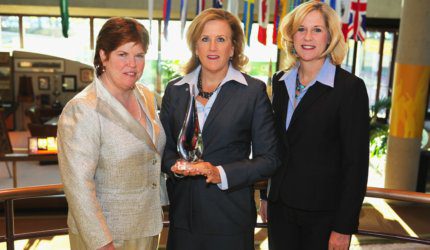Since the first training class took place 50 years ago in the basement of a restaurant in Elk Grove Village, Ill., McDonald’s USA has made employee learning and development the centerpiece of growth.
“It’s not something we have to work hard to get support on,” said Diana Thomas, McDonald’s vice president of U.S. training. “Early on [McDonald’s founder] Ray Kroc recognized that if he wanted to go anywhere he needed to invest in talent. That has continued to be part of who we are.”
Today, Hamburger University at the company headquarters in Oak Brook, Ill., is the centerpiece of the company’s approach to developing people. According to company figures, more than 80,000 restaurant managers and owner/operators have graduated since 1961, learning about restaurant operations, product quality, customer service and value.
Restaurant performance in those areas is important, but so is each employee’s career development. Students can earn college credit for Hamburger University coursework through a partnership with the American Council on Education.
“It goes to show there’s a culture of learning in support of developing people throughout McDonald’s,” Thomas said.
While tradition and culture are elements of McDonald’s success in employee development, close alignment with business strategy is another. The company’s five-year business strategy, “Plan to Win,” lays out short- and long-term goals in five areas: people, product, place, price and promotion. Part of that plan is a focused development strategy targeting restaurant crew members, shift managers and store leaders that continues to show value, from the corporate office down to the restaurant level, Thomas said.
“It’s not like we’re doing something separate on the side. We’re constantly focused on driving our strategic plan to win. We’re not trying to figure out what should we be doing. Our focus is on the business.”
Driving business via people development starts with assembling a strong learning and development team. Thomas said Hamburger University is staffed by people committed to the business and to helping students grow in their careers.
“If they’re not some of our highest-performing individuals with the potential to continue to grow, we’re not going to bring them into the training group,” Thomas said. “Because of how quickly we’re moving and how adaptive we need to be to continue to evolve, we need the very best people.”
To meet those evolving needs, McDonald’s USA deploys a mix of centralized and decentralized training, conducting courses and development at the corporate training center but also in 22 regional locations and on site at 14,000 restaurants. Courses, materials and methods developed in the U.S. are shared with training groups worldwide, allowing them to leverage the company’s global reach while customizing resources where necessary for each local audience.
Hamburger University also invested in technology, including classroom collaboration tools, e-learning and virtual classrooms. Technology is part of a blended learning approach that combines e-learning with on-the-job practice, coaching and performance reviews. The company’s new learning management system opens up further opportunities.
“We’re also excited about continuing to strengthen our training measurement strategy, and we’ll continue to leverage the learning management system now that we have more rich data,” Thomas said.
That measurement strategy includes a mix of internal learning and operational metrics that are benchmarked and tracked on a monthly basis against the company’s annual operator survey. Results are also linked to corporate performance in restaurant operations, customer satisfaction and opinion and financial returns, as well as employee engagement, retention and succession.
While McDonald’s USA has enjoyed a long history of serving learners that has garnered recognition, Thomas said it’s important to stay aligned with business needs and stay grounded in what is happening in the broader learning and development field.
“It’s critical for learning leaders to stay abreast of what’s going on and have a network you can tap into because you definitely can’t have all the answers in yourself or your team,” she said. “There are so many best practices and people willing to share in the learning industry.”
Mike Prokopeak is editorial director of Chief Learning Officer magazine. He can be reached at mikep@clomedia.com.















